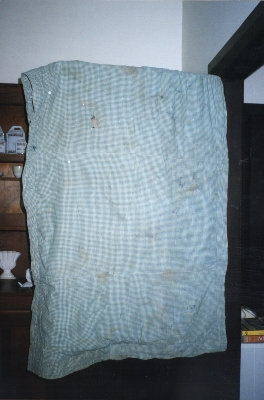Quilt No.234WG - Win Groves

Owner:
Win Groves
Location:
SA Country
Maker
Maker:
Win Groves
Made in
AUSTRALIA WA
Date:
1941 - 1970
Description:
Wholecloth quilt with front and back of green and white check gingham. The filling is made from jumpers, suitings, warm skirts etc. Machine sewn.
1800 x 1050mm
1800 x 1050mm
History:
Made by the owner Win Groves in Pingrup, WA in 1966. Now used as a drop sheet for painting, and for packing when shifting furniture.
Story:
Made as a necessity for warmth on the farm (Pingrup in WA), when cash was low, and they were new land farming in 1966. Cover of green check gingham was the original kitchen curtains in the first house (1952) in Broken Hill. Machine sewn on a 'Singer' treadle sewing machine.
Related Quilts:
Wholecloth pram quilt with a top of pink cotton sateen, and the reverse is a more finely woven, ivory, fabric. All over quilting design as main feature, with stylised hearts, leaves and cross hatching. The padding is cotton batting. 870 x 660 mm.
Hand stitched, cotton, appliquéd, quilt in a flower pattern on a plain background. Colours are shades of green, apricot and browns. This quilt was known as a 'Bride's Quilt'. Padding is thought to be layers of white fabric raised almost like a wadding. The backing is cotton material. 2470 x 2020 mm.
Wholecloth quilt in satin, crimson one side and yellow on the other. Hand quilted in an all over pattern. The padding is wool.
2300 x 1700mm
2300 x 1700mm
Taylor's sample quilt made from men's suit swatches, mainly greys and blues. Edging is 6cms wide, of blue flannelette. Padding is an old grey blanket, and the backing is of printed pattern corduroy. 1680 x 920 mm.
Quilt remnant. This piece of the top is hand embroidered in gold thread on a background of burgundy silk in a traditional style still practised by Greek women today. The backing is white and probably cotton or linen.
940 x 430mm
940 x 430mm
Patchwork quilt of multi coloured silks and brocades. Crazy patchwork borders, mainly rectangular fabrics pieced together in diagonal patterns, radiating from a central frame embroidered with flowers. Many pieces are extensively embroidered in a great variety of stitches and motifs; butterflies, sunflowers, cats, daffodils, crown, pawn broker's symbol, 'money to lend', 'good night', the initials of family members and 'mater 1890'. The quilt has a deep border of maroon sateen. There is no padding visible but it is possibly a blanket. The backing is green/gold silk with a self stripe with red cotton damask showing underneath, possibly an earlier backing.
2165 x 2165mm
2165 x 2165mm






